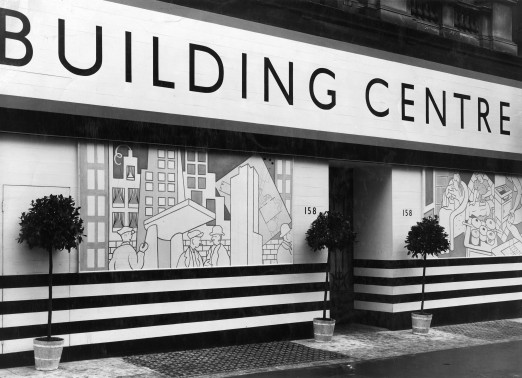As we celebrate the Building Centre's anniversary, we look at 90 years of housing through the Centre's pioneering public programme.
The UK’s relationship to housing has shifted dramatically over the Building Centre’s 90 years. The 1930s saw a boom in house building and in 1933 the Centre launched its seminal low-cost housing competition to design three-bedroom cottages. 300 designs were sent into the competition and a pair of the winning scheme’s semi-detached houses, designed by Mr. N. E. Leeson from Newcastle-on-Tyne, were built for less than £500 in London’s Aldwych. By the time they were closed in September 1933, they had been visited by 20,000 people including the Prince of Wales, and there were plans to build them across the UK.
Their success brought about the introduction of a low-cost housing section in the Building Centre’s materials library and led to the Building Centre’s next design competition for Workmen’s Flats. The competition was accompanied by an ambitious survey, published as a book called ‘Housing in Europe’, compiled by Judith Ledeboer.
This period saw the rise of public housing provision in the UK and by 1939 about one in ten households lived in council accommodation. This accelerated after WWII, and a proliferation of public sector housing provision meant that by the end of the 1970s one in three, or 35% of households in the UK lived in public housing.
During this time the Building Centre was a forum for discussion on contemporary building issues including the prefabrication methods used in many new housing developments. In a seminar on 'Industrialised or System Building' in 1966, it was concluded that the lack of agreement of acceptable tolerances was ‘extremely urgent’. Just two years later, the system-built Ronan Point tower block in east London collapsed, killing three people.
A decade later, the 1980s marked a turning point in UK housing provision and ideology. The Right to Buy scheme encouraged house ownership and marked the selling off of council’s housing stock and the privatisation of housebuilding, with a lasting legacy. By 2007 the proportion of the population in local authority housing stood at only 10%.
This was the same year that the Building Centre turned its attention to sustainability and exhibited No.1 Lower Carbon Drive – a full scale model of a Victorian terraced house – in Trafalgar Square. The house, by AOC, showcased the numerous ways in which visitors could transform their home to reduce CO2 emissions and achieve zero carbon – from insulation to waste.
In 2014 the Building Centre paired this need for low-energy housing with the necessity of addressing a worsening housing crisis. Wikihouse 4.0 – a house prototype by architects Zero Zero and Arup engineers – was exhibited on the Store Street Crescent. It explored how open source technology might positively impact the UK housing crisis and scale up the self build market, by creating a low-energy house that anyone can download, adapt, ‘print’ and assemble for themselves in a few days, for under £50k.
So where are we now? The housing crisis prevails with 8.4 million people in England living in an unaffordable, insecure or unsuitable home according to the National Housing Federation. House building is at its lowest since 1946, while the population continues to rise – although it is estimated by social geographer Danny Dorling that there are currently enough empty properties in the UK to house two million people. It is increasingly clear that we have a crisis of distribution, as housing acts as a capital accumulator for private investment.
Could community organisation through land trusts and self-building with the aid of democratised automation provide a step in the right direction for housing provision? We’ve been looking into it through our latest collaboration with AUAR Labs House Block for Hackney Council.





